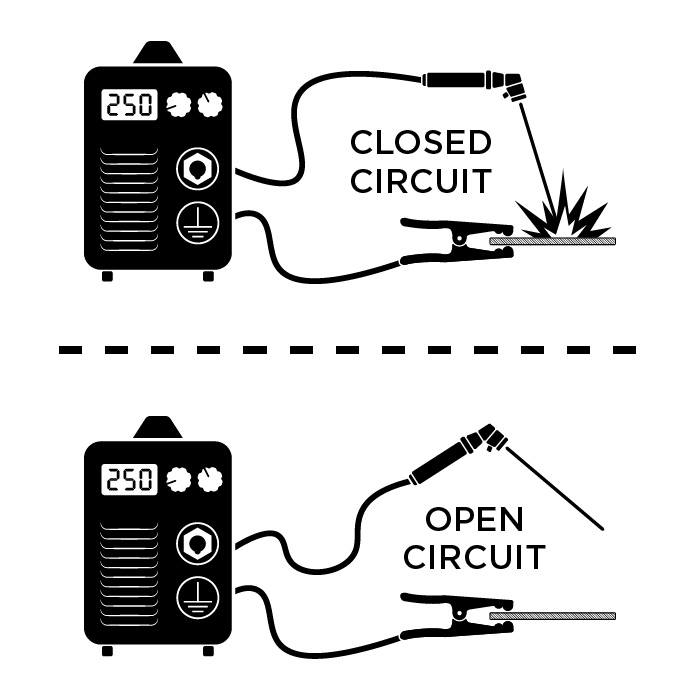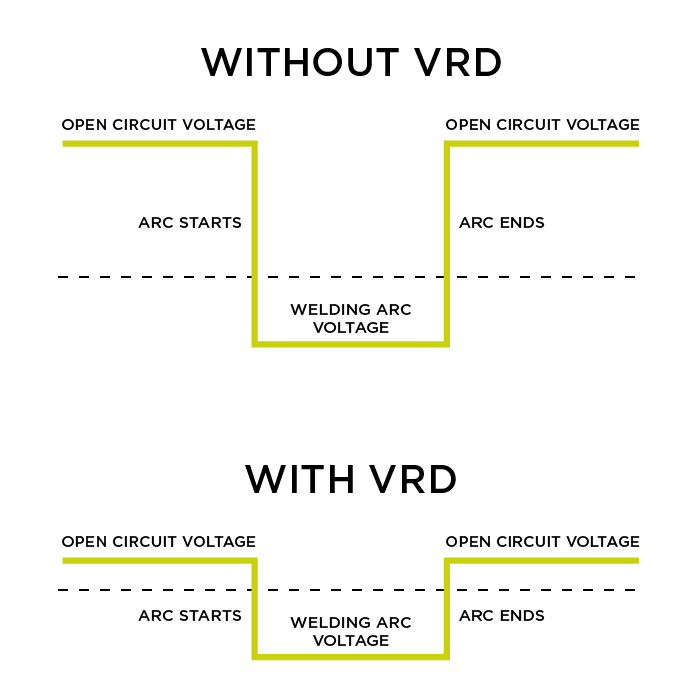What is the Voltage Reduction Device (VRD) in a Welder?
March 21, 2022
These days, almost every stick welder has it, but that doesn’t mean that it’s always needed or used. We’re talking about the VRD, or Voltage Reduction Device.
Like most things to do with welding, it’s another feature that’s for your safety. If you’re working on a building site or in a mine, you’ll be required to have a machine with VRD. So, what exactly does it do?
What does a VRD do?
A VRD reduces the open-circuit voltage of a welding machine.
When the welding machine is on, but not being used (like when you’ve just finished an electrode and need to grab a new one), the VRD kicks in and lowers the voltage to a safer level (usually around 13V).
When you’re welding, a complete (or closed) electrical circuit is formed. The power source (in this case, the welder) has electricity flowing through it into the metal, which creates the arc, which creates the weld.
The metal you’re welding is connected back to the welder by the earth clamp, producing a complete electric circuit.
When you stop welding, the circuit stops being closed and instead becomes open. The electricity isn’t going anywhere. It’s just idling inside the power source, like a car idling at a red light. This is called the open-circuit voltage (OCV).

By reducing the OCV when the welder isn’t being used, the risk of being electrocuted is dramatically reduced.
Why is a VRD used?
Your open-circuit voltage will depend on how powerful your machine is. Typically speaking, a stick welder will have an OCV of about 85V, but that can get as high as 110V for really demanding work. On the other hand, your small home DIY stick welder will have an OCV of 50V.
An OCV of about 75V will be able to start an arc on the first strike without the rod sticking, even on stubborn electrodes, like low-hydrogen 7018s.
In normal conditions, open and dry spaces, those voltage levels are relatively safe. The natural resistance in your skin can withstand the zap, and you wouldn’t even feel it with gloves or other PPE on.
However, if it’s damp or humid, that’s where you need a VRD. When your skin becomes wet from washing your hands or sweating in your gloves, the resistance in your skin drops considerably.
If you’re working in confined spaces or off ground level, a VRD is also needed. Accidentally touching the electrode with your bare skin while being in contact with the earth can result in an electric shock, which can be deadly if you can’t get away from the source of it or it disrupts your balance.
Having a VRD kick in and reduce the open-circuit voltage level keeps you safe, which is why you won’t be allowed to work on-site if you don’t have it. They can be internally or externally installed.
How does a VRD work?
The VRD is automatic. It detects the level of resistance against the welding terminal and turns on (reducing the OCV) as necessary.
When the resistance level is high, for example, if the air, your gloves or even your skin is against the machine’s output (the electrode holder for stick welding), the VRD will activate.
When the electrode touches the workpiece, the resistance level drops, which the VRD will recognise and turn off, allowing the open-circuit voltage to increase back to normal levels to start the arc.
When you finish welding and the VRD once again detects a high resistance, it will switch back on after a short delay.

Though the VRD automatically switches off when you begin a new weld, it may react slowly. A delay in reaching a higher open-circuit voltage means it can be difficult to start an arc, as there’s not as much power running through the machine.
Some electrodes, like low-hydrogen or cellulose ones, can often already be difficult to start, so trying to strike them with the VRD active on your welder can be a real struggle.
Note: DO NOT turn your VRD off when you are on-site. Not only is it for your own safety, but it could also be illegal.
A VRD only comes into play if you’re welding without a trigger. When you’re stick welding or lift arc/scratch start TIG welding, the machine is live as soon as it is turned on.
In comparison, MIG welding and high-frequency TIG requires a trigger press to ignite the arc. There is no voltage flowing through the machine otherwise, so there is no need to protect the operator from excess voltage.
Almost every UNIMIG welder has a VRD installed, but it’s not always on. For example, if you purchased a VIPER 185, the VRD would only kick in when the machine was switched to ‘MMA’ and wouldn’t affect your MIG welding at all.
Some people might not love that their stick welds are hard to start, but VRDs are an essential part of keeping welders safe while they work.